As 2004 marches on, President George W. Bush's chances for winning re-election on Nov. 2 improve each time a new poll shows his approval rating remaining above 50%. Gallup polling over the past half-century shows that the five incumbent presidents who won re-election maintained approval ratings above 50% from the spring of that year through the election. The approval ratings of the three incumbent presidents who lost their re-election bids were below the 50% mark at this time in the election season.
Many pundits contend that this year's presidential election may be decided only in a few key battleground states, where the close margin in 2000 suggests they could swing toward either Bush or his presumptive Democratic opponent John Kerry. In fact, neither Bush nor Kerry has spent much time campaigning outside these key swing states in recent weeks. So just how do residents of key battleground states evaluate Bush? And what do his approval ratings mean for his re-election odds?
For this analysis, Gallup combined the results of its 10 most recent surveys, which include more than 10,000 interviews conducted between mid-January and mid-April, and examined what Gallup calls the "red" states (states Bush won by more than five percentage points in the 2000 presidential election), the "blue" states (states Al Gore won by more than five points), and the "purple" states or key battleground states, where the margin of victory for either candidate was five points or less in the 2000 election. The key battleground states, or "purple" states, include Arkansas, Florida, Iowa, Maine, Michigan, Minnesota, Missouri, Nevada, New Hampshire, New Mexico, Ohio, Oregon, Pennsylvania, Tennessee, Washington, and Wisconsin.
Overall Results
The aggregated poll results show that a slim majority of Americans, 51%, approve of the way Bush is handling his job as president, just slightly above the 50% threshold that separates presidents who won re-election from those who did not. Forty-six percent of Americans disapprove of Bush's job performance.
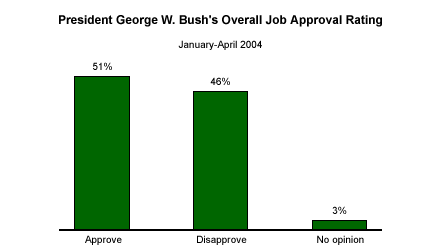
Approval Ratings in the Red, Blue, and Purple States
The president's job approval ratings, perhaps not surprisingly, are substantially higher in the so-called red states than they are in the blue or purple states.
- Red states. Fifty-seven percent of Americans living in the red states approve of the way Bush is handling his job as president, while 40% disapprove.
- Blue states. Only 45% of blue state residents approve of Bush. The majority, 52%, disapproves.
- Purple or battleground states. As might be expected, the margin between Bush's approval and disapproval ratings is much closer in the competitive battleground states. Fifty percent of those living in these purple states approve of Bush, while 47% disapprove.
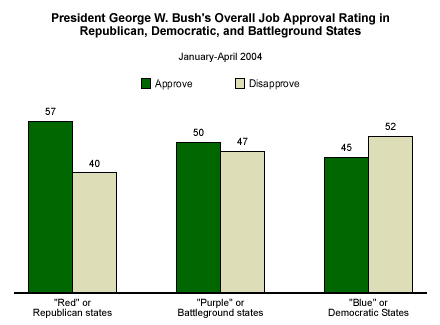
Bush Approval in the Battleground States
The aggregate results also show some interesting differences among demographic subgroups in the purple states.
A majority of Americans in the following groups in the purple states approve of Bush: Republicans, conservatives, those earning $50,000 or more annually, men under age 50, college graduates, men in general, 30- to 49-year-olds, and whites.
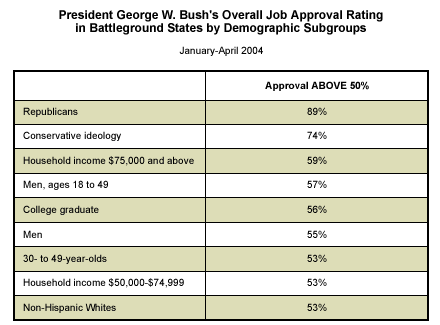
The approval ratings of several groups in the purple states hover slightly above the 50% mark. These include men aged 50 and older, those with some college education, and those earning between $30,000 and $50,000 a year.
Just half of those aged 50 to 64 and those with a high school diploma or less education approve of Bush.
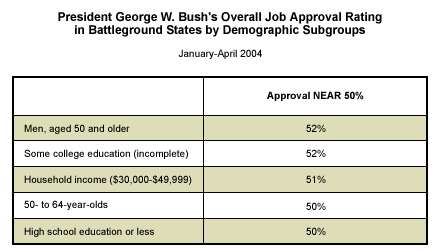
Some of the groups with approval ratings of Bush below 50% include younger Americans, independents, women, highly educated people, lower-income people, moderates, liberals, blacks, and of course, Democrats.
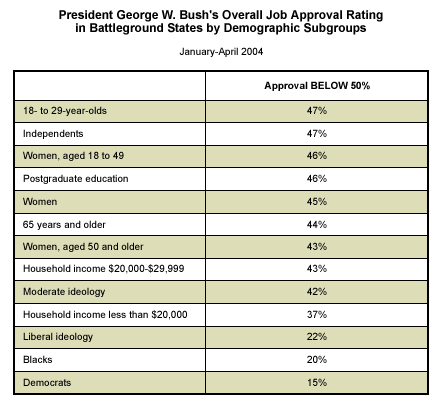
Bottom Line
With an approval rating of just 50% in the purple states, history suggests Bush is right on the line between possible re-election and defeat. All of these and other results point to what could be a repeat of the close presidential election in 2000.
*These results are based on telephone interviews with a randomly selected national sample of 10,049 adults, aged 18 and older, conducted in 10 polls from mid-January 2004 through mid-April 2004. For results based on this sample, one can say with 95% confidence that the maximum error attributable to sampling and other random effects is ±1 percentage point. In addition to sampling error, question wording and practical difficulties in conducting surveys can introduce error or bias into the findings of public opinion polls.
For results based on the sample of 3,569 adults living in the "red" states, the maximum error attributable to sampling and other random effects is ±2 percentage points.
For results based on the sample of 2,762 adults living in the "blue" states, the maximum error attributable to sampling and other random effects is ±2 percentage points.
For results based on the sample of 3,723 adults living in the "purple" or competitive battleground states, the maximum error attributable to sampling and other random effects is ±2 percentage points.
